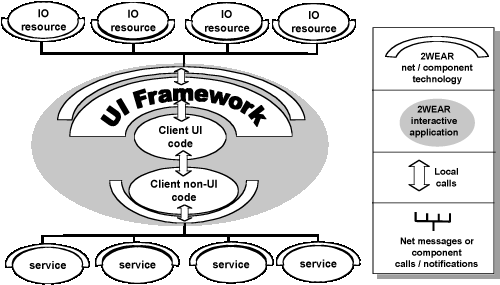|
|||
|
 |
| The development role of the Voyager User Interface development framework in developing mobile distributed applications in the 2WEAR project. |
The Voyager toolkit places abstract interactive objects (the Selector and TextEntry) at the service of the programmer, hiding run-time coordination and control details, and revealing only semantic characteristics at the API level. These objects are internally linked to the lower-level management of remote UI resources to cater for I/O control through various levels of specialisation that are completely hidden to the application programmer. Programmers thus have an effective instrument to easily craft mobile dialogues with diverse dynamic UI I/O resources. Furthermore, the single-focus policy for objects and applications has been enforced, meaning that a single application can have the focus in a mobile system and that only the focus object will actually allocate resources for interaction purposes. This modality, which is concurrently supported in Windowing systems, turned out to be a necessary decision in mobile interactions, since the physical display 'breadth' of the devices which are dynamically engaged does not allow concurrent dialogues to be practically supported.
When new resources appear, if dialogue is 'suspended', no action is taken, since the application does not own the focus. Otherwise, the Voyager UI framework substitutes the instantiation of the current focus abstract object with the best possible I/O instantiation without affecting the state of the focus abstract object. When new UI resources are discovered, the UI framework finds the best possible I/O instantiations by recycling the resources currently used by the focus, plus those just discovered, as well as those that are not granted and are thus available. If the best instantiations found are the ones currently in use, no actions are taken. Otherwise, the current I/O instantiations are released (assuming dialogue was not 'stalled', in which case those instantiations are null), while the current best-found input and output instantiations are activated (when output instantiations are activated, or when they are associated with a different abstract object, they call their display method automatically). In the case where the dialogue was previously in a 'stalled' state, and is now in a 'working' state, dialogue revival is automatically signalled.
When UI resources are lost (either due to network failure, or to lack of responsiveness, or because the services are gracefully removed), if the dialogue is already 'stalled', no further action is taken. Otherwise, the UI framework asks the current focus object if it happens to use any of the lost resources. If not, no action is taken, but if this is the case, the current input and output instantiations are released, and a configuration round is entered, seeking for the best possible input and output instantiations. If no such instantiations can be found with the currently available resources, the dialogue is signalled as 'stalled'. Otherwise, the input and output instantiations that have been found are activated.
To conclude, the challenges in implementing mobile interactive applications capable of dynamically utilising the UI resources discovered in the surrounding environment are: (a) handling the dynamic resource coordination and control requirements at runtime, and (b) offering a compact and invariant programming model which is intact from the variety of dynamic UI resources. The Voyager UI development framework has been expressly designed and implemented to address these two challenges.
Please contact:
Constantine Stephanidis, ICS-FORTH
Tel: +30 2810 39 1741
E-mail: cs@ics.forth.gr


